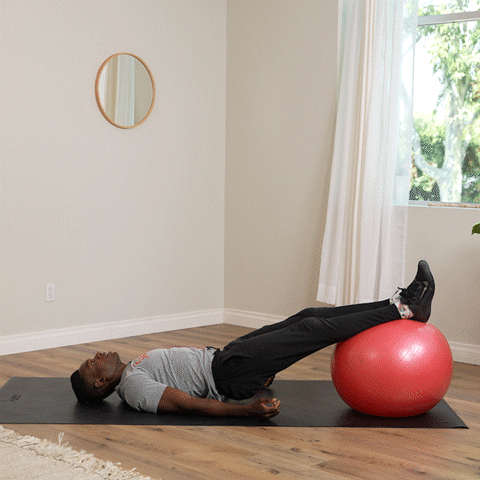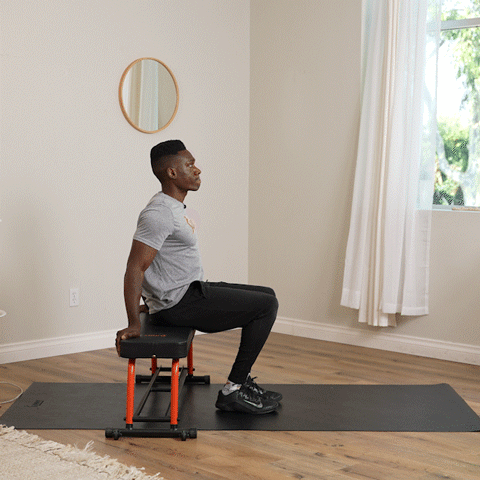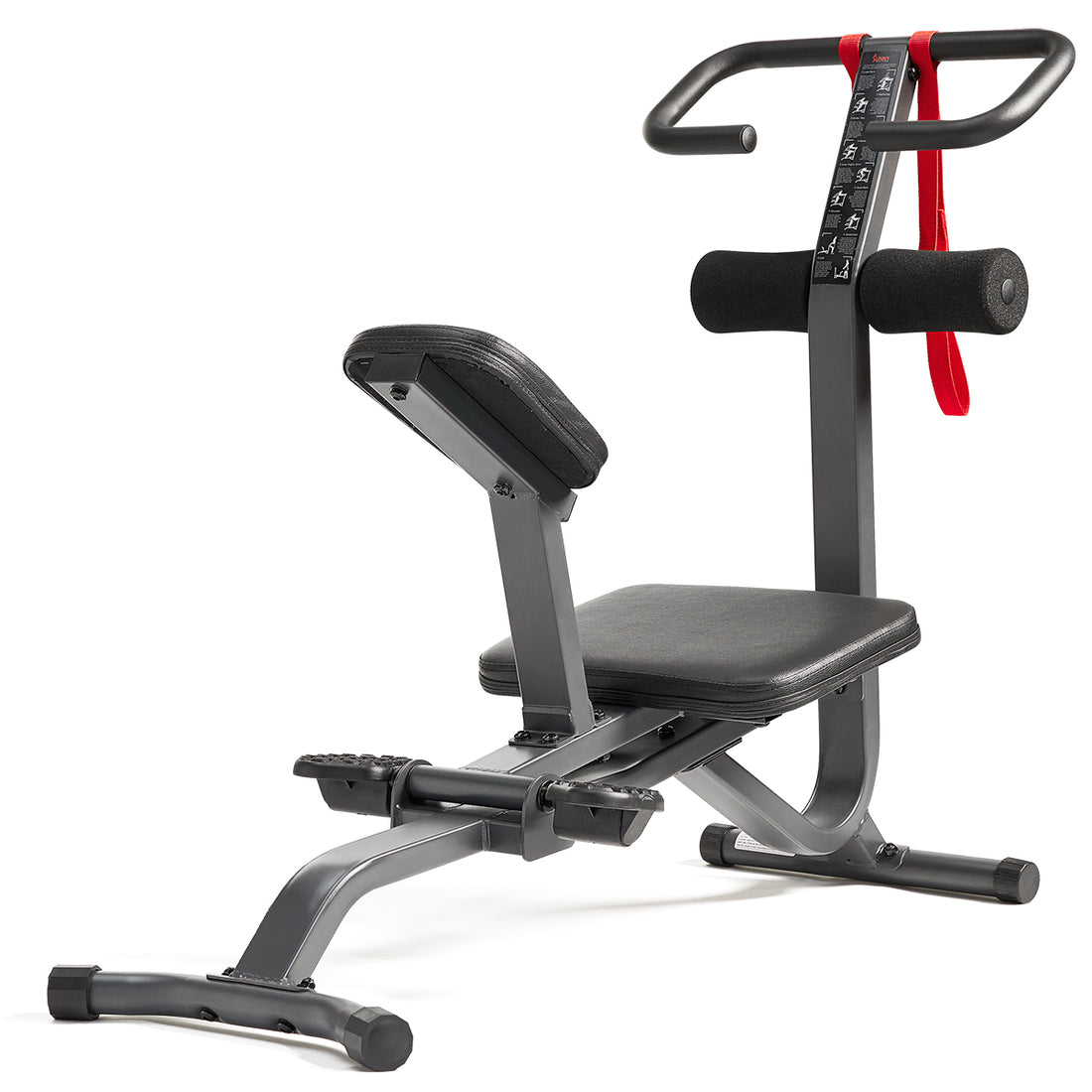For pure versatility—mobility, strength, muscle gain, increasing the heart rate, sports performance, and aesthetics—the squat is way ahead of the game. What if knee pain seems to creep up anytime you squat? Well, if not squatting doesn’t bother you, that’s fine. But what if you actually WANT to squat but can’t? This article will show you what you can do to both reduce or eliminate the pain and find a squat style that works for you.
Reducing the Pain
As much as we would like to just jump in, it’s helpful to try to figure out the cause of the pain and reduce it as much as possible.
Now, only a medical professional can diagnose the exact cause of your pain, but through using different mobilization tools, including stretching, you may be able to figure out what reduces the pain and thereby what you need to do to manage it.
Improve Mobility in Quadriceps
Rolling out your quadriceps with a foam roller can help reduce tension on the kneecap.

Stretching the quadriceps, which is best done AFTER foam-rolling, can further reduce tension on the kneecap. If this bothers your knee, though, focus on foam-rolling.

Improve Ankle Mobility
During a squat, it’s essential to keep your heels planted. If they rise up unintentionally, the knee moves excessively forward, putting pressure on the knee.
Rolling out the calves with a foam roller—as uncomfortable as it might be—can increase ankle mobility, which in turn keeps your heels planted and your knees in a safer position.
Dealing with ankle mobility issues can also be improved by performing squats with your heels elevated. More on this later!
Improve Hip Mobility and Learn Correct Hip Movement
If your hips don’t move during a squat—if all of the movement is at the knees—that’s a lot of potential stress on the knees that could have been offset onto the hamstrings, glutes, and lower back (a strong, pain-free lower back, by the way).
First, build up the necessary mobility to move your hips at all by stretching them, first and foremost.

Then, it’s time to learn correct hip movement. The glute bridge exercise strengthens the glutes, which you will use to stand yourself up from the bottom of the squat. The glutes also help keep the knees from collapsing inwards and instead lined up with the feet, reducing strain on specifically the outer knee tendons.

The Romanian deadlift strengthens the hamstrings and lower back, and teaches you how to hinge properly at the hips. If you feel a stretch in your hamstrings at the bottom of the movement, you’re doing it right!

Strengthen the Hamstrings
In line with improving hip mobility is strengthening the hamstrings, which are the muscles of the back of the upper thigh.
The Ball Ham Curl exercise is perfect for strengthening the hamstrings in an isolated, graduated fashion.

Activate the Quadriceps
For a select group of people, the quadriceps do not “engage” or “fire” properly on the way down. Usually, this culminates in coming down too fast with little control over what the knee is doing.
To address this, it helps to “activate” the quads prior to squatting.
Quad Pulses involve sitting on the floor with your legs straight in front of you with a rolled-up towel under the problematic knee. Extend or “straighten” your knee and hold for 1-2 seconds. Do this ten times per leg. Seated version shown below:

As I said earlier, tight quads can be the cause of some knee discomfort, so you have to proceed carefully. But once the quads are pulling their weight (so to speak), you’re a large step closer to pain-free squatting.
Cueing the Knee Back
“Cueing” essentially means teaching you what to focus on while you squat.
Here is a simple way to “cue” you to keep your knees back. Place a tall foam roller on its end and stand with the toes of one foot right up against it, pointing at it so that if your knee came too far forward, it’d push the roller over.
Then try to squat without pushing the roller over. Can you do it your first time?
Also, think about keeping your knee lined up with the roller. This “cues” you to keep your knees out.
Carefully try it and see how it feels!
Teaching “Knees Out”
Placing a small elastic band around your legs (just below the knees) and pushing the knees out while squatting or even while seated can have immediate benefits.
Lastly, when you’re performing actual squats, keep your “knees out” and feel your knees become stronger and stronger!

Now Let’s Find Your Squat
To find your squat, the key is finding the movement that is PAIN-FREE. Once you’ve established pain-free movement, then you can experiment more and build on the progress you’ve made.
Any squat style that incorporates more hip movement into the squat is your friend. Here are some bodyweight and weighted examples.
Box Squat

Box Squats refer to any squat where you’re lowering yourself to a box, chair, bench or other surface. Box squats are especially useful for cueing you to “sit your butt back” as you squat, which reduces stress on the knee.
Starting high, use boxes of different heights until you’ve established pain-free movement and lower as needed.
Goodmornings
No, that’s not a typo! The Goodmorning exercise is the monarch of all lower-back exercises. It is performed with a barbell bar or bodybar in the Low-Bar position (see below), and involves only a small amount of knee bending, with 9/10ths of the movement originating in the hips.
It is essentially a Romanian Deadlift with the bar on your upper back. Strengthening your lower back, hamstrings, glutes, and also your upper back without putting stress on your knees makes the Goodmorning an extremely useful option, and it also prepares your for...
Low-Bar-Style Squats
The positioning of the bar on your back is what gives this squat its name. Instead of resting on the “upper traps,” the bar sits just below the top crest of the shoulder blade.
But you can do “low-bar-style” squats without a barbell. It’s all about how much you sit back and bend over at the hips. I.e. how “hip-dominant” the squat is.
The main things to remember: Take a wider stance than you might normally take. On the way down, sit your butt back, bend over at the hip keeping your lower back straight, and keep your knees out. On the way up, don’t let your knees come forward or inward, and focus on driving your hips up.
More Upright Squat Styles
Not everyone will be able or built to perform hip-dominant squats, so here are some movements that allow you to stay more upright while attempting to minimize strain on the knee joint.
Wall Ball Squat

This squat style allows you to remain completely upright, but if you use the cue to “tuck your butt under the ball,” you can incorporate more hip movement, thereby reducing strain on the knee while still working the entire leg. Be careful not to put the feet too far forward.
Supported Squat (Machine or Improvised)
Any squat in which you can hold onto something, like a beam, squat rack, suspension trainer, or the back of a heavy couch, and “sit your butt back” can help you squat with less knee pain and allow you to establish pain-free movement.
What Have We Learned?
If squatting is what you want to do, it may take some time to establish pain-free movement. It can be frustrating to not be able to “just do it,” as the old ad says. But with the tools in this article, and with the help of any required medical professionals, you can experience all of the wonderful benefits of squatting too, and with your new, pain-free knees!
Enjoy!


Mark Ludas CPT is a NASM-certified personal trainer with a decade of experience in the fitness industry. After an asthmatic childhood, Mark discovered his natural aptitude for fitness in his late twenties. At age 36, he accomplished a 300+ pound conventional deadlift and 280+ high-bar squat as a 6’5” 170-pound ectomorph on a fully vegan diet, all after just one year of proper self-programming. Mark is the founder of Resistance Quest Fitness, established in 2016. Additionally, he is a writer, actor, model, and musician. Find him on Instagram, Facebook, Youtube, and at www.resistancequest.com.
























Add Your Name & Email
Please enter your name and email to continue.We won’t display your email publicly.
1 comment
Thanks for this teaching – can hardly wait to put into practice. Because of excessive knee pain, I took a week off from YMCA’s Group Power/Active classes, which consisted of a lot of weighted squats and lunges,